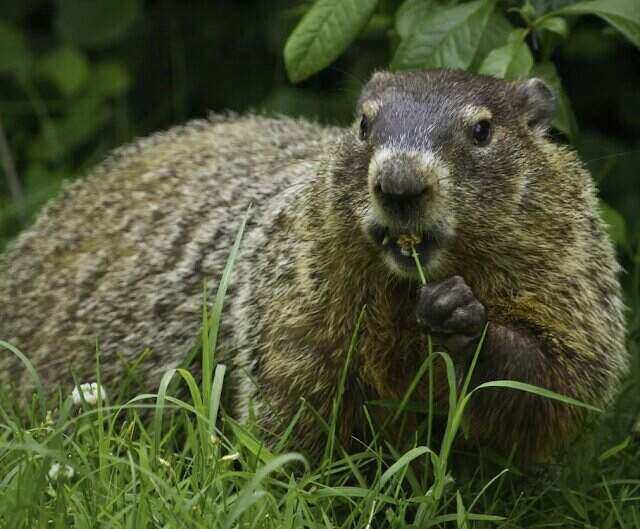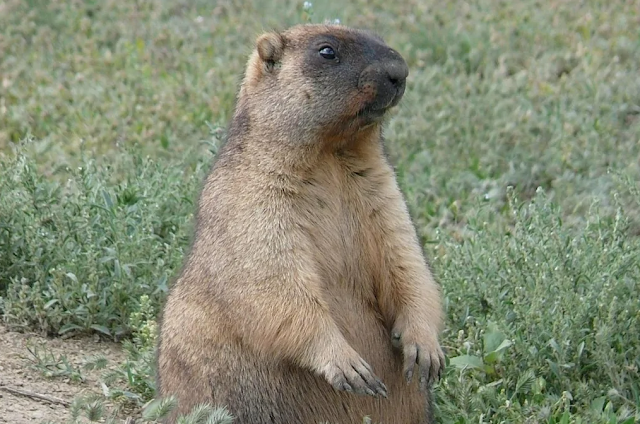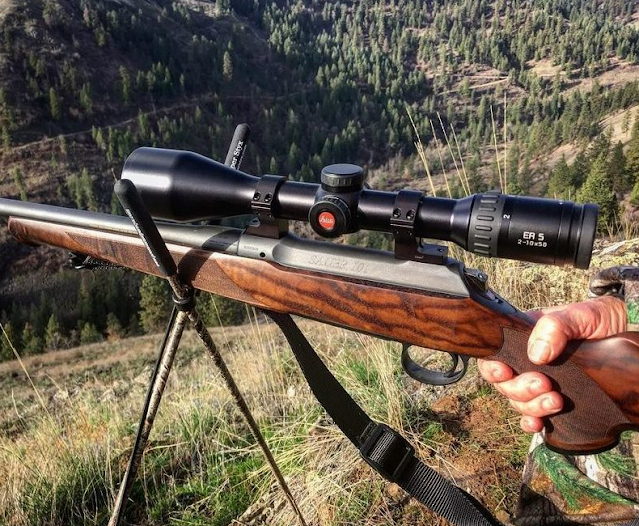How to Hunt Groundhog?

Hunting groundhogs is an exciting activity in the wild that the hunting community enjoys due to the ease of the hunt and the opportunity to acquire several kilos of tasty meat and valuable fur.
This article will describe the main aspects of hunting these cunning and fast animals and provide tips for improving the effectiveness of even novice shooters.
Table of Contents
- What Are the Characteristics of a Groundhog?
- What is the Best Time to Hunt Groundhogs?
- Hunting Equipment: What Do You Hunt a Groundhog With?
- Hunting With Different Weapons
- What Caliber to Choose?
- How Do You Hunt Groundhogs?
- How to Save Groundhog Meat?
- What Do They Do With the Groundhog After the Hunt?
- Conclusion
What Are the Characteristics of a Groundhog?
It is necessary to reveal all the secrets of catching energetic prey from a general acquaintance with it. It is worth telling what it is and where this cunning animal lives. Groundhog is an animal from the squirrel family. The largest specimen of it. The average weight of such an animal is from 2 to 7 kilograms. Individual samples of this breed can gain weight of over 10 kilograms.
The habitat of groundhogs is in the plains of North America (extending from Alabama to Alaska). Plain steppes and mountain steppes are also very well suited for the life of groundhogs. Any more or less experienced hunter fell in love with hunting groundhogs because of the valuable fur of his skin and tasty and healthy meat.

Any groundhog has a large, mostly squat, flexible body, a small, oblong head, and small ears. His sense organs are well developed. Cunning and shy by nature. It lives mainly in branched, rather deep burrows, crawls out of them to satisfy hunger, but always does not move far from the entrance to its dwelling hole.
In complete darkness, permanent dwelling in the depths of holes allowed the groundhog to develop special organs of touch and orientation in the dark on the lower jaw, called vibrissae. Nature also gave the groundhog a magnificent and fluffy tail with high-quality hard plumage, which serves as an excellent balance for the animal to move in the “galleries” of holes at high speed.
At the same time, the groundhog’s front paws are created and adapted for digging the ground, which, together with the balancer tail, gives it the convenience of building branched corridors of its housing and its functional movement on two hind legs.
He has excellent hearing and vision, and to the extent of his shyness and speed of movement, these sense organs help him escape from natural predators or human hunters hunting for him.
What is the Best Time to Hunt Groundhogs?
Officially, the state hunting period for groundhogs opens in May and continues throughout December. During the day, when there is burning heat on the plains or the mountain steppes, it is almost useless to hunt this animal. The groundhog does not like intense heat, which means it will not appear from its mink during such a period.
It is also tough to detect in complete darkness and even more so to shoot. But when there comes a slight coolness and freshness in the predawn hour, or with the onset of twilight, there is no rain, and the sky is clear – the most productive moments come to get the coveted trophy to shoot the groundhog.

Groundhogs show up from their holes almost daily in the flat steppes and mountainous areas at such hours. And hunters who want to get a productive result should take care of a thorough survey of the site, setting the exact hour the animal leaves the hole, create a high-quality ambush or ambush for the hunting process itself, and also take care of the correct selection of hunting equipment and weapons for an accurate shot.
Hunting Equipment: What Do You Hunt a Groundhog With?
To hunt a groundhog, in any case, you will need:
- Vehicle: Groundhogs live in the steppe, and often during groundhog hunting, you have to overcome considerable distances;
- Binoculars: to look out for a target from afar;
- A flexible steel cable or hose about 3 meters long with a tee at the end; with its help, they get a dead animal out of the hole;
- Camouflage suit, for example, steppe or mountain camouflage, depends on the place of hunting;
- When hunting with rifled weapons, you will still need a rangefinder to determine the distance to the target and an emphasis on the gun. It can be a bipod, a tripod, or even a backpack or a folded jacket.
Moreover, the choice of the rest of the equipment and equipment depends on the method of hunting you choose.
Hunting With Different Weapons
The groundhog is a very vigilant animal. They can notice the danger from a distance of up to half a kilometer and immediately hide in a hole, indicating danger. It is also solid on the wound, and since it is always near the entrance to the hole, it is not uncommon for a mortally wounded groundhog to hide in a hole from where it isn’t easy to get it. To avoid this, it only needs to shoot in the head. These two factors influence the choice of weapons and methods of hunting.
Groundhog hunting is carried out with various weapons, ranging from air rifles or small things to long-range rifled sniper rifles. At the same time, for different weapons, they use their hunting methods.
Smoothbore
Smoothbore weapons are not very suitable for groundhog hunting. Hunters use it when shooting at 30–40 meters, sneaking up on an animal, or shooting from an ambush. And for sneaking up, there are quite a few different ways.

They usually shoot with 00 or 000 shots or buckshot. Immediately after the shot, they run quickly to the hole to prevent the wounded animal from hiding.
Rifle
The best choice for groundhog hunting is a rifled weapon. Most often, self-loading carbines with an optical sight are used for this. They shoot from a hundred meters and up to a kilometer inclusive.
In the latter case, we are usually talking about warming. It uses high-end, long-range rifles and optical sights. Shooting is carried out from special tables or stops. This method of shooting groundhogs came to us from America and is not so much a hunt as a sporting event with animals as targets. That is why it is not very welcome in most countries.

During ordinary groundhog hunting, shooting from a rifled gun is carried out at a distance of 150-300 meters. They usually shoot in the head. After the shot, they try to pick up the prey quickly.
Alternatively, you can use a small-caliber rifle with optics. In this case, hunters work at a distance of 70-100 meters, approaching with the help of sneaking up. They try to shoot in the eye. The advantage of small things is not such a loud shot.
Air Rifle
Modern air rifles, in their parameters, have already become full-fledged hunting weapons. Shooting them requires more accuracy but creates less noise.

Groundhog hunting requires powerful pneumatics, with an energy of 16 Joules and above, with good optics. Shooting is carried out at distances of 40 meters. They hunt with sneaking, approximately the same as with a small-caliber rifle.
What Caliber to Choose?
For smoothbore weapons, the caliber does not matter. It can be either 12 or 20-gauge. The main thing is to use ammunition with 00 shot or buckshot.
Rifles are recommended in calibers from 5.45 to 7.62 mm. A smaller caliber may not pierce a groundhog from a long distance, while a larger one will tear the carcass apart. Sometimes quite large calibers are used for warming, but usually, they are not interested in prey. A caliber of at least 5.5 mm for hunting with pneumatics is required; more is better.
How Do You Hunt Groundhogs?
For each type of weapon described above, there are several popular types of groundhog hunting, which it would be sinful not to touch upon in covering all the nuances and details of the description of hunting for such prey. Thus, here are the most basic and productive categories of capturing a restless steppe animal in their content.
Hunting With a Goat’s Tail
Since the groundhog is a sharp-sighted and cautious animal, it usually does not allow a short shot, for example, from a smoothbore gun. To get close, hunters use many different methods. One of them is hunting with a goat’s tail.
A goat’s tail is a device made from the tail of a white goat or tied into a large bun from a white ponytail tied to a short stick. Taking advantage of the natural curiosity of this animal, the hunter approaches it, rotating or waving the white brush of the “goat’s tail” in front of him, distracting and redirecting the animal’s attention. It is somewhat similar to hypnosis, which does not allow the animal, trying to consider an unfamiliar threat better, to hide in a hole.
They approach the groundhog first with a measured step, then crouching, and at the end, crawling without stopping distracting movements. Once at a distance of a shot, usually already lying down, they aim, shoot, and quickly run to pick up prey, not allowing them to hide in a hole.
Hunting With Traps
When catching a groundhog, traps No. 3 and No. 5 are the most effective. They are installed near the hole, where the groundhog spends most of his time. To do this, they dig a recess to the total size of the trap, mask it, sprinkle it with earth, and cover the working part with a thin sheet of paper, dusting it with dust on top. The trap must be fastened with a chain so that the animal cannot hide with it in the hole.

In addition to large individuals, small groundhogs, ferrets, and other representatives of the steppe fauna that hunt this animal can fall into the trap. Therefore, the traps are adjusted with such an effort that it does not break bones and does not cripple.
In the case of capturing groundhogs older than two years, they immediately kill them, breaking the cervical vertebrae, and the young and other animals are released. The teeth can immediately determine the age of the groundhog. In adults, they are yellow and large.
Hunting With Burrowing Dogs
Groundhogs are very social animals. Usually, they settle next to their relatives, so their burrows often form huge settlements. Their burrows are of two types, temporary and brood. Temporary ones are used in the summer for overnight stays and shelter from predators. This is a hole, usually with a vertical tunnel up to a meter deep and two outlets at the bottom into a large sleeping chamber and a small toilet chamber.
Brood burrows are usually huge shelters made of burrows of many individuals woven into a single network, with many passages, chambers, and exits. Such towns reach a depth of four meters, and the length of their passages is up to one hundred meters. In mountainous areas, their shelters can lie on rocky ground.
Groundhogs can be a challenge for dogs, especially when it comes to navigating their burrows. The animals’ unique anatomy, which lacks a distinct neck and allows their heads to retract into their bodies, makes it difficult for dogs to get a good grip. Additionally, groundhogs’ sharp front incisors can be used as a weapon, making it even more challenging for dogs to handle them, especially if they are large and healthy.
Therefore, dogs are usually used to extract wounded animals hidden in a hole when hunting groundhogs. This works incredibly well when shooting from a long distance. Very often, the groundhog, on its last gasp, goes into a hole, where it dies not far from the entrance. It is tricky and time-consuming to extract it with various devices, but the dog copes with this fine.
Most burrowing dogs are suitable for these purposes, but dachshunds, fox terriers, and Jagd terriers are especially good. In addition to pulling prey out of the hole, such a dog will indicate in which hole the wounded animal has disappeared and easily find it in the intricacies of burrows without being distracted by its other inhabitants.
The depth of the desired hole can be determined by the amount of soil thrown out nearby. It is advisable to equip the dog’s collar with a special transmitter showing its location and depth. According to the rules, running dogs into the hole without a leash is recommended.
However, experienced hunters still run the dog on a rope in a special harness to help it pull out quite heavy, up to 10 kilograms, and voluminous prey. In addition, the rope helps control the dog to stop it in time, preventing it from getting carried away. Practice shows that hunting with a dog is always more productive than without it.
Varminting
It is a fascinating but unique hunting craft used to extract groundhogs. More related to the sporting type of prey of just such an energetic animal under certain, obviously established conditions for the hunter to evaluate the skill of the hunter, his accuracy. Many call this type another type of sniping – a sports shooting hobby. Varminting has some strict conditions that the shooter must strictly adhere to. Instead, it is suitable for masters – miners, experienced, and very experienced hunters.
There can be a lot of conditions for varminting, and each type is individual. The main thing is to show your shooting accuracy. The minimum distance from which the defeat of this beast is made in the head is at least 100 meters. Further, there may be instructions on limiting ammunition in case a groundhog is a hit and many other conditions.
How to Save Groundhog Meat?
The most valuable in this prey, especially if the hunter could hit the groundhog in the head, is its tasty and healing carcass meat, fur skins, and fat. It is easy to save the first two options if all the rules for cutting the killed animal, prompt transportation of prey, and its storage are observed. The most difficult to preserve is groundhog fat. It has a high activity and the shortest retention period after the animal’s death.
The second and third times spoil meat and fur skins. It is recommended to first study the method of cutting its carcass, the step-by-step separation of potentially dangerous parts and organs of the groundhog, which become the causes of spoiled fatty masses of the animal, its meat, and fur, which have healing properties. For example, it is worth removing the animal’s bladder and axillary sweat glands, which can actively react and directly affect the fat and meat of the animal.
What Do They Do With the Groundhog After the Hunt?
The primary value of a groundhog is fat. For proper preparation, fresh fat is immediately cleaned of blood and meat. You need to store it without access to light. Otherwise, it deteriorates faster.
Before melting, the fat is crushed, for example, in a meat grinder. It should be heated with as little air as possible and preferably in a steam bath at fewer than 100 degrees. Keeping fat in a metal container for a long time is not advisable. After melting, it is poured into small glass jars and stored in a sealed state in a dark, cool place.

Frequently Asked Questions
Question: What is a groundhog?
Answer: A groundhog, also known as a woodchuck or whistlepig, is a burrowing rodent found throughout much of the eastern United States.
Question: Why would I want to hunt a groundhog?
Answer: Groundhogs can cause damage to crops, gardens, and landscaping. Hunting them can help control their population and mitigate the damage they cause.
Question: What equipment do I need to hunt a groundhog?
Answer: Basic hunting equipment such as a firearm or bow, appropriate ammunition or arrows, and camouflage clothing are necessary. Additionally, binoculars and a ground blind may be helpful.
Question: What time of day is best for groundhog hunting?
Answer: Groundhogs are most active during early morning and late afternoon, so these times may be ideal for hunting.
Question: What type of habitat do groundhogs prefer?
Answer: Groundhogs prefer areas with tall grass or brush near open fields, where they can forage for food and remain hidden from predators.
Question: How do I locate groundhogs?
Answer: Look for signs such as burrow entrances, chewed vegetation, and droppings. You can also use binoculars to scan fields and open areas for groundhogs.
Question: What techniques can I use to hunt groundhogs?
Answer: Groundhogs can be hunted using a variety of methods, including stalking, sitting in a ground blind, or calling them with a predator call.
Question: Is it legal to hunt groundhogs?
Answer: Hunting regulations vary by state and municipality, so it’s important to check local laws and obtain any necessary permits before hunting groundhogs.
Question: How do I safely handle and dispose of a harvested groundhog?
Answer: Wear gloves when handling a harvested groundhog and dispose of it in a manner that is safe and legal, such as burying it or taking it to a designated disposal site.
Question: Can groundhog meat be eaten?
Answer: Groundhog meat is edible, but it may not be to everyone’s taste. Before eating groundhog, be sure to follow proper cleaning and cooking procedures to ensure it is safe to eat.
Conclusion
Summarizing the entire brief overview of groundhog hunting, I would like to note that if the hunter treats his craft competently, prepares well for each trip, does not be greedy, and does not lead a cruel poaching way of hunting wildlife, he will be able to receive a multi-colored spectrum of positive emotions from each trip for the soul and a backpack full of tasty and healthy prey.







